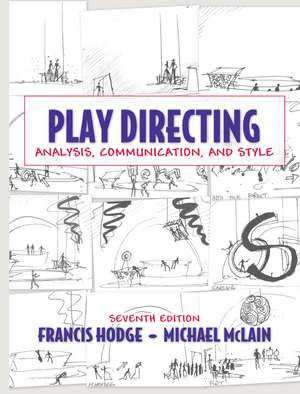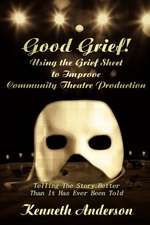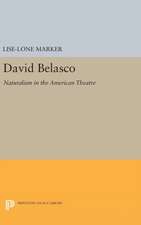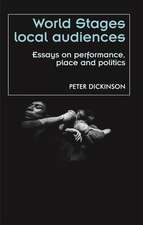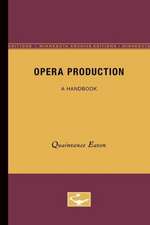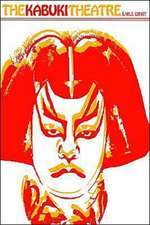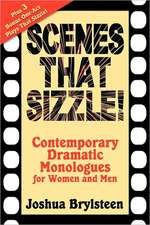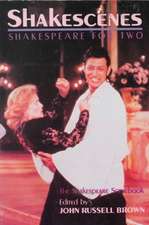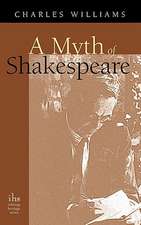Play Directing: Analysis, Communication, and Style
Autor Francis Hodge, Michael McLainen Limba Engleză Hardback – 23 iun 2009
Preț: 1102.21 lei
Preț vechi: 1509.87 lei
-27% Nou
Puncte Express: 1653
Preț estimativ în valută:
210.94€ • 219.41$ • 174.14£
210.94€ • 219.41$ • 174.14£
Carte disponibilă
Livrare economică 25 martie-08 aprilie
Livrare express 08-14 martie pentru 79.22 lei
Preluare comenzi: 021 569.72.76
Specificații
ISBN-13: 9780205571246
ISBN-10: 0205571247
Pagini: 406
Dimensiuni: 189 x 246 x 20 mm
Greutate: 0.68 kg
Ediția:7Nouă
Editura: Taylor & Francis
Colecția Routledge
Locul publicării:Oxford, United Kingdom
ISBN-10: 0205571247
Pagini: 406
Dimensiuni: 189 x 246 x 20 mm
Greutate: 0.68 kg
Ediția:7Nouă
Editura: Taylor & Francis
Colecția Routledge
Locul publicării:Oxford, United Kingdom
Public țintă
UndergraduateCuprins
Dedication
Preface and Credits for Photographs.
1. Why the Director?
2. What Is a Play? Analysis and Improvisation.
I. PLAY-ANALYSIS: TAKING A PLAY APART.
3. The Foundation and Facade of the Playscript: Given Circumstances and
Dialogue.
4. The Core of the Playscript: Dramatic Action and Characters.
5. Idea and Rhythm-Mood Beats.
6. The Director's Preparation.
II. COMMUNICATION 1: THE DIRECTOR-ACTOR RELATIONSHIP AND STAGE BLOCKING
7. Directing Is Working with Actors 1.
8. Learning to See: The Games of Visual Perception.
9. Helping Actors Communicate through Groundplans.
10. Composition: Helping Actors Discover and Project Basic Relationships.
11. Helping Each Actor Intensify: Gesture and Improvisation with Properties.
12. Picturization: Helping a Group Intensify.
13. The Dynamic Tool of Movement.
14. Coordinating the Blocking Tools in Director-Actor Communication.
15. Helping Actors “Speak” a Play
16. Directing is Working with Actors 2.
Major Project 1A: Scene Practice.
Major Project 1B: Diagnostic Criticism.
COMMUNICATION THROUGH STAGING OPTIONS .
17. The Director’s Responsibility for Working Effectively with Design.
18. The Director and the Stage Machine: Symbolization and Synthesis.
19. Director's Options: Choice of the Stage.
20. Director's Options: Scenery, Properties, and Lighting.
21. Director's Options: Costume, Makeup, and Sound.
HELPING AUDIENCES RECEIVE A PLAY
.
22. Responsibility to Audiences.
Major Project 2: Designing and Directing Your Own One-Act Play Production.
III. INTERPRETATION: A MATTER OF STYLE.
23. Style Is Individual Expression.
24. Style in Playwriting and Playwrights.
25. The Director's Analysis of Style in a Playscript.
26. Style in Production: Making Decisions.
27. Style in Production: Modern Plays.
28. Style in Production: New Plays.
29. Style in Production: Plays of Past Ages.
IV. COMMUNICATION 2: THE DIRECTOR-DESIGNER RELATIONSHIP
30. Preparing To Be a Collaborator in the Design Process
31. Directing Is Working with Designers
Major Project 3: Directing a Full-Length, Fully-Produced Play with Designers
Appendix 1. Directing Musical Theatre and Opera.
Appendix 2. The Director and the Dramaturg.
Appendix 3. Your Future as a Director.
Bibliography.
Index.
Preface and Credits for Photographs.
1. Why the Director?
2. What Is a Play? Analysis and Improvisation.
I. PLAY-ANALYSIS: TAKING A PLAY APART.
3. The Foundation and Facade of the Playscript: Given Circumstances and
Dialogue.
4. The Core of the Playscript: Dramatic Action and Characters.
5. Idea and Rhythm-Mood Beats.
6. The Director's Preparation.
II. COMMUNICATION 1: THE DIRECTOR-ACTOR RELATIONSHIP AND STAGE BLOCKING
7. Directing Is Working with Actors 1.
8. Learning to See: The Games of Visual Perception.
9. Helping Actors Communicate through Groundplans.
10. Composition: Helping Actors Discover and Project Basic Relationships.
11. Helping Each Actor Intensify: Gesture and Improvisation with Properties.
12. Picturization: Helping a Group Intensify.
13. The Dynamic Tool of Movement.
14. Coordinating the Blocking Tools in Director-Actor Communication.
15. Helping Actors “Speak” a Play
16. Directing is Working with Actors 2.
Major Project 1A: Scene Practice.
Major Project 1B: Diagnostic Criticism.
COMMUNICATION THROUGH STAGING OPTIONS .
17. The Director’s Responsibility for Working Effectively with Design.
18. The Director and the Stage Machine: Symbolization and Synthesis.
19. Director's Options: Choice of the Stage.
20. Director's Options: Scenery, Properties, and Lighting.
21. Director's Options: Costume, Makeup, and Sound.
HELPING AUDIENCES RECEIVE A PLAY
.
22. Responsibility to Audiences.
Major Project 2: Designing and Directing Your Own One-Act Play Production.
III. INTERPRETATION: A MATTER OF STYLE.
23. Style Is Individual Expression.
24. Style in Playwriting and Playwrights.
25. The Director's Analysis of Style in a Playscript.
26. Style in Production: Making Decisions.
27. Style in Production: Modern Plays.
28. Style in Production: New Plays.
29. Style in Production: Plays of Past Ages.
IV. COMMUNICATION 2: THE DIRECTOR-DESIGNER RELATIONSHIP
30. Preparing To Be a Collaborator in the Design Process
31. Directing Is Working with Designers
Major Project 3: Directing a Full-Length, Fully-Produced Play with Designers
Appendix 1. Directing Musical Theatre and Opera.
Appendix 2. The Director and the Dramaturg.
Appendix 3. Your Future as a Director.
Bibliography.
Index.
Notă biografică
Francis Hodge, late. Hodge was a Professor Emeritus in The University of Texas at Austin Department of Theatre and Dance and served as professor of directing from 1949–79.
Michael McLain participated in the founding of the Geffen Playhouse as its initial Literary Director and Artistic Associate, and he was similarly involved in the founding of the School of Theater, Film and Television as its first Associate Dean for Theater. As a Fulbright-Scholar, Professor McLain conducted research in the areas of directing and director training in the former Soviet Union. Subsequently, he was a member of the first faculty exchange between the UC and what was then Leningrad State University. In 2011, Prof. McLain became a Fellow of the Likachev Foundation, St. Petersburg. In over three decades of teaching in the Department of Theater, Prof. McLain directed works by Shakespeare, Chekhov, Brecht and Sam Shepard, among many others, and he is the co-author of "Play Directing: Analysis, Communication and Style," now in its 7th edition from Allyn & Bacon. He is a consultant to the government of Hong Kong in the area of theater curricula for graduate and undergraduate programs
Michael McLain participated in the founding of the Geffen Playhouse as its initial Literary Director and Artistic Associate, and he was similarly involved in the founding of the School of Theater, Film and Television as its first Associate Dean for Theater. As a Fulbright-Scholar, Professor McLain conducted research in the areas of directing and director training in the former Soviet Union. Subsequently, he was a member of the first faculty exchange between the UC and what was then Leningrad State University. In 2011, Prof. McLain became a Fellow of the Likachev Foundation, St. Petersburg. In over three decades of teaching in the Department of Theater, Prof. McLain directed works by Shakespeare, Chekhov, Brecht and Sam Shepard, among many others, and he is the co-author of "Play Directing: Analysis, Communication and Style," now in its 7th edition from Allyn & Bacon. He is a consultant to the government of Hong Kong in the area of theater curricula for graduate and undergraduate programs
Descriere
Play Directing describes the various roles a director plays, from selection and analysis of the play, to working with actors and designers to bring the production to life.
